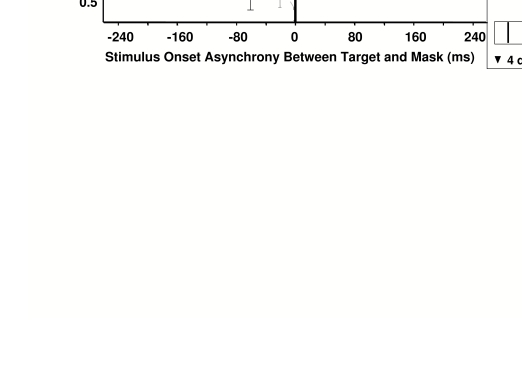Figure 14.
Psychophysical length-discrimination measurements of visual masking from 23 human subjects using overlapping opaque masks of varied size (the distance from the mask’s edge to the target’s edge was 0°, 0.5°, 1°, 2°, or 4° as indicated in the insert). The subject’s task was to fixate on the central black dot and choose the longer target (right or left). Targets were black bars presented for 30 milliseconds; masks were also black and presented for 50 milliseconds. Targets turned on at time 0 ms, and masks were presented at various onset asynchronies so that they came on before, simultaneous to, or after the target in 20 ms steps. Stimulus onset asynchronies (SOAs) to the left of zero indicate forward masking conditions and SOAs greater than zero indicate backward masking. Miniature gray markers with dotted connecting lines represent conditions during which the target and mask overlapped in time and so the target was partially or completely occluded by the mask. The targets were 0.5° wide and had varied heights (5.5°, 5.0°, or 4.5°) and were placed 3° from the fixation dot. The mask was a bar 6° tall with varied widths, spatially overlapped and centered over each target. There were 540 conditions (2 possible choices X 2 differently sized target sets to foil local cue discrimination strategies X 5 overlapping mask sizes X 27 stimulus onset asynchronies). Each condition was presented in random order 5 times to each subject, over a period of 2 days, for a total of 62,100 trials (summed over all 23 subjects). Reprinted from Macknik, et al. (2000).

